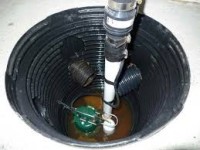If you are one of the thousands of people who fear the rain, you are not alone. Many people in the Midwest fight the losing battle of a wet basement or worse yet a flooded basement battle annually. The American Society of Home Inspectors estimates that more than 60 percent of homes have issues with water in the basement.
A sump pump may be an effective option for preventing water damage. Installed in a pit in the basement, these units sense when the water from rain or snowmelt is rising in the pit and approaching the floor level. The incoming water is then pumped outside before it can damage the home or its furnishings, thus leaving your basement dry.
Sump pumps are relatively low-maintenance devices, but you can help keep your unit operational by inspecting it regularly. Steps in a regular maintenance program can include:
- Checking the discharge line to make sure it is not stopped up or frozen. If necessary, unclog the air vent hole in the line.
- Checking the inlet screen to ensure that it’s not clogged with residue and debris. This should be done three or four times per year.
- Make sure the float component is unobstructed and can move smoothly.
- Scanning the pit and removing any debris not to impeed a discharge of water.
- Testing the pump by slowly pouring a bucket of water into the pit. The float should rise with the water level, triggering the unit to start pumping. Thus making sure all of the working parts haven’t seized up. If pumping doesn’t begin, check to see that the unit is plugged in.
- Going outside to see that water is discharging and flowing where it’s supposed to go – well away from your home.
If you are having any problems with your sump pump not working properly or it has already seized up, then call Omaha's best plumbing company, Micro Plumbing, Inc. (402) 895-1212. We will help you get things back in working order. “Big or Small We Do It All”.

